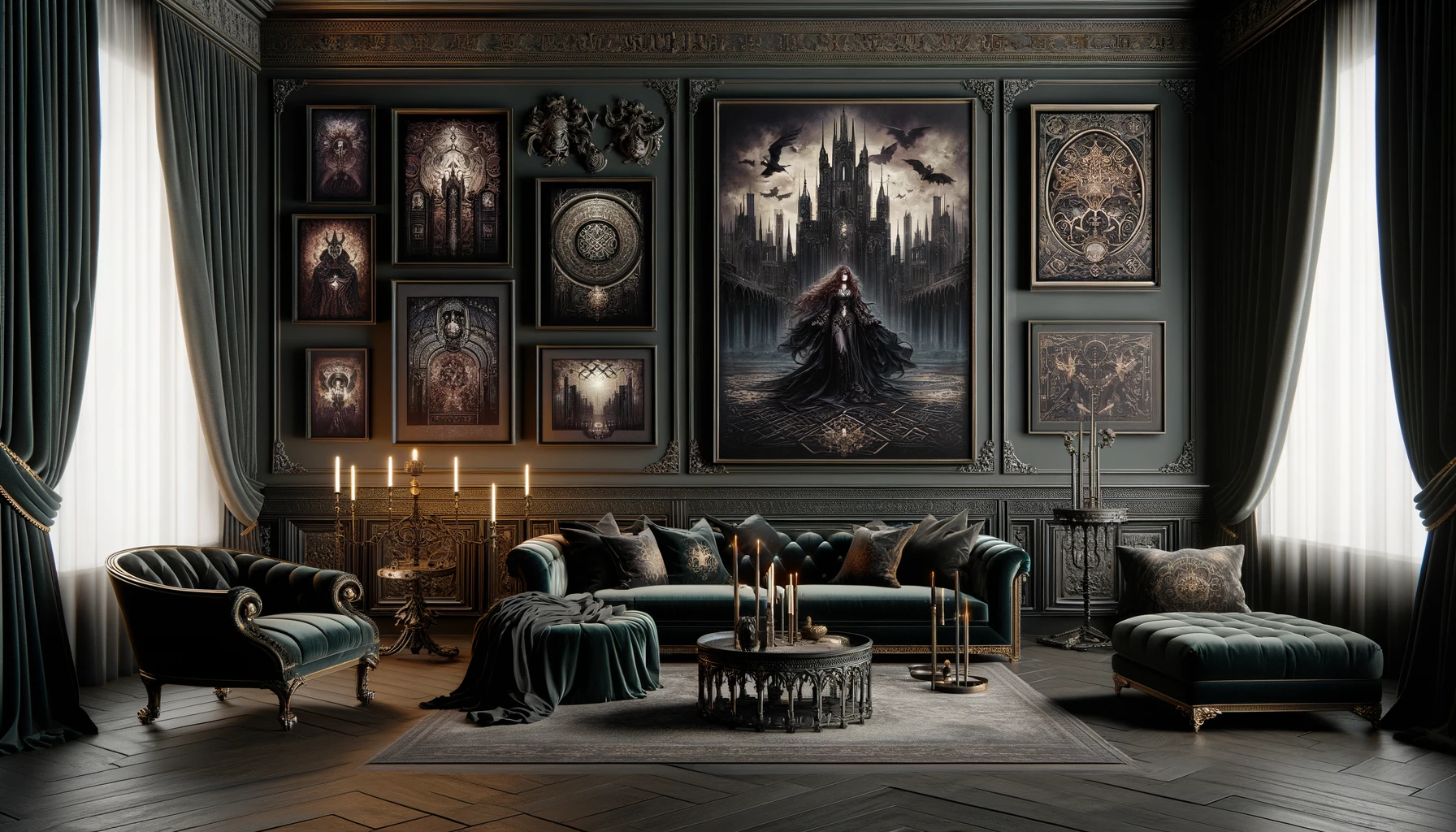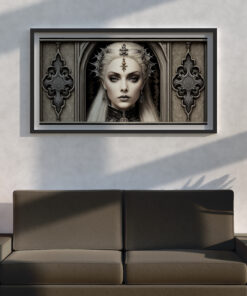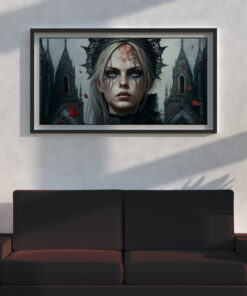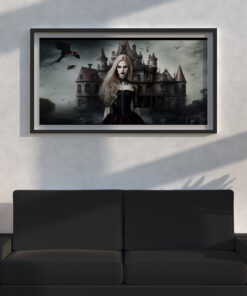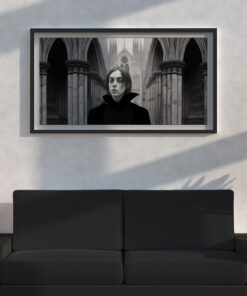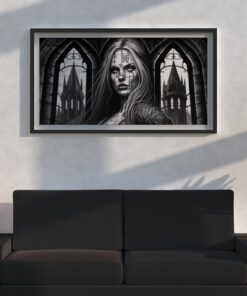
Modern Gothic Artists to Watch
Modern Gothic art, a genre that intricately blends the medieval with the contemporary, offers a profound exploration into themes of darkness, beauty, and the complex human condition. This genre has evolved significantly from its historical roots, embracing new mediums and perspectives to comment on modern society’s nuances.
The Evolution of Gothic Art

From Medieval to Modern
Gothic art originated in the Middle Ages, characterized by its architectural marvels, such as cathedrals and abbeys, which showcased pointed arches, ribbed vaults, and flying buttresses. Fast forward to the contemporary scene, and modern Gothic art has expanded beyond architecture into painting, sculpture, and digital media, transforming traditional Gothic themes with modern sensibilities.
The Role of Technology and Media
In the current era, technology plays a pivotal role in the development and dissemination of Gothic art. Digital platforms, virtual exhibitions, and mixed media have opened new avenues for artists to express Gothic themes, reaching a wider audience than ever before. Interactive installations and digital art embody the modern Gothic spirit, merging historical elements with futuristic visions.
Defining Characteristics of Modern Gothic Art
Modern Gothic art is not just a reimagining of Gothic architecture and medieval themes but a vibrant genre that encompasses a wide range of artistic expressions. Here are some defining characteristics:
- Symbolism and Depth: Modern Gothic art is rich in symbolism, often delving into themes of existential angst, the sublime, and the exploration of light versus darkness.
- Creative Diversity: Today’s Gothic artists employ a variety of mediums, from sculptures and portraits to video art and interactive media, showcasing the genre’s adaptability.
- Cultural Commentary: Modern Gothic art often serves as a commentary on contemporary issues, reflecting on society’s shadows and light.
Key Themes and Motifs
- Existentialism and Transcendence: Many works explore profound existential questions, using Gothic motifs to delve into life, death, and what lies beyond.
- Contrast between the Ancient and the Modern: Artists juxtapose Gothic elements with modern-day realities, creating a dialogue between the past and present.
- Architectural Influence: The influence of Gothic architecture—with its emphasis on verticality and light—persists, inspiring artworks that echo these structures’ spiritual and aesthetic aspirations.
Modern Gothic Art: A Tapestry of Influences
Modern Gothic art is a dynamic field influenced by a variety of cultural, historical, and artistic currents. Renaissance, Baroque, and Romanticism have all contributed to the genre’s development, with artists drawing on these movements to create works that are deeply reflective and inherently complex. The integration of Gothic and modern elements results in a genre that is both a homage to the past and a commentary on the contemporary human experience.
By embracing a broad spectrum of influences and media, modern Gothic art continues to evolve, pushing boundaries and challenging perceptions. Through its rich symbolism, diverse mediums, and profound thematic explorations, this genre offers a unique lens through which to view the complexities of modern life and the enduring allure of the Gothic tradition.
Gothic Artists for Wall Art
Discover a selection of artists whose work embodies the gothic aesthetic, perfect for adding a touch of darkness and intrigue to your walls:
- Mark Ashkenazi – Known for his vibrant and often surreal works that can add a modern gothic flair to any space.
- Lourry Legarde – Creates hauntingly beautiful landscapes and scenes imbued with a deep, gothic sensibility.
- Michael Creese – Specializes in paintings that often feature gothic themes, blending the mystical with the natural world.
- Bob Orsillo – His work often explores darker themes, making his pieces a great choice for gothic wall art.
- Mona Edulesco – Known for her colorful yet darkly themed paintings that can add a unique gothic touch.
- N Akkash – Offers a range of artworks featuring gothic and fantastical elements, perfect for those looking to add a dark narrative to their walls.
- Mango Art – Provides a selection of gothic-inspired art, including reinterpretations of classic pieces with a modern twist.
- AM FineArtPrints – A collective offering prints that delve into the gothic, from eerie landscapes to shadowy figures.
- Suzann Sines – Her portraits, often inspired by gothic literature and horror, bring an elegant darkness to any room.
- Christian Chapman Art – Known for his rock and roll influenced gothic art, perfect for a more contemporary space.
- Jane Small – While not exclusively gothic, her work often carries a mystical, ethereal quality that can complement gothic decor.
- Megan Aroon (MADART) – Offers vibrant, gothic-themed paintings that blend the dark with the colorful in unique ways.
- Studio Grafiikka – Specializes in vintage and gothic-inspired travel posters, offering a unique take on gothic art.
These artists offer a range of gothic wall art options, from traditional gothic imagery to modern interpretations, ensuring there’s something for every taste and decor style.
Understanding Modern Gothic Art
The exploration of modern Gothic art delves into a genre that intricately blends the medieval with the contemporary, showcasing a profound narrative of human emotion, existential dread, and a fascination with the macabre. This section outlines the defining characteristics and thematic concerns of modern Gothic art, providing insights into its significance in today’s cultural landscape.
Key Characteristics of Modern Gothic Art
Symbolism and Narrative Depth
Modern Gothic art is renowned for its rich symbolism and narrative depth. Artists utilize Gothic motifs such as cathedrals, abbeys, and vampires to explore themes of loneliness, despair, and the search for meaning. These symbols are not mere representations but are imbued with complex significances that resonate with contemporary existential concerns.
- Existential Angst and Transcendence: Works often delve into existential questions, using Gothic architecture and mythology as metaphors for the human condition.
- Contrast and Duality: The juxtaposition of light and darkness, both literal and metaphorical, is a common motif, symbolizing the dualities of life and the complexity of human emotions.
Diverse Mediums and Techniques
The modern Gothic genre embraces a wide array of mediums and techniques, reflecting its adaptability and the creative diversity of its artists. From traditional sculptures and paintings to digital art and mixed media installations, the genre offers a multifaceted approach to exploring Gothic themes.
- Digital Art and Technology: The use of digital technology in creating Gothic art allows for innovative expressions of traditional themes, including virtual reality experiences and interactive installations.
- Sculpture and Fine Art: Modern Gothic sculptures and fine arts continue to draw on medieval and Gothic traditions, infusing them with contemporary insights and materials.
Cultural Commentary and Social Critique
Modern Gothic art serves as a potent medium for cultural commentary and social critique. By drawing on Gothic and medieval imagery, artists comment on modern society’s ills, from the alienation of the individual in the urban landscape to critiques of contemporary social and political issues.
- Urban and Architectural Decay: Many artists explore themes of decay and degradation, using urban and architectural motifs to reflect on societal collapse and the loss of cultural heritage.
- Reinterpretation of Historical and Mythological Themes: Artists reinterpret Gothic and medieval themes to critique or highlight contemporary issues, blending historical narratives with modern contexts.
Exploring the Depths of Modern Gothic: A Comprehensive Overview
Contemporary Gothic: A Dark Artistic Movement
The Contemporary Gothic movement, emerging from the 1997 “Gothic” exhibition at the Institute of Contemporary Art in Boston, delves into themes of darkness and horror. This movement draws inspiration from gothic music genres like heavy, black, and death metal, as well as gothic novels and horror films. It is characterized by a fascination with the unsettling and the mortal, blending contemporary surrealistic elements with mysticism, shamanism, the occult, and the grotesque. Notable artists such as Alexander McQueen and Gottfried Helnwein have contributed to defining the movement’s aesthetic, which also touches on themes of medical/health, the fantastic, and childhood fantasies influenced by old masters.
The New Wave of Goth and Darkwave Bands
In the music scene, Goth and Darkwave genres are experiencing a resurgence, highlighted by bands that performed at the Cruel World festival and celebrated on World Goth Day. This revival is not just a nod to the past but a reimagining, blending classic goth elements with modern influences. Bands like Creux Lies, Twin Tribes, and She Past Away are at the forefront, showcasing the genre’s evolution while maintaining its core essence. Their music, often using drum programming and exploring themes of the macabre and personal introspection, demonstrates goth’s enduring appeal and its ability to adapt and thrive in the contemporary music landscape.
Modern Gothic Paintings: A Visual Feast
Modern Gothic Paintings offer a rich tapestry of visual art that explores gothic themes through a contemporary lens. Artists featured on Fine Art America, such as Mark Ashkenazi and Lourry Legarde, present works that encapsulate the modern gothic aesthetic. These paintings, ranging from abstract interpretations to detailed gothic scenes, reflect the movement’s diversity and its impact on visual arts. The collection includes a variety of subjects, showcasing how modern gothic art can both enchant and unsettle, inviting viewers into a world where the dark and the beautiful coalesce.
New Gothic: The Art Movement Redefined
New Gothic, or Neo-Gothic, is a term coined by Charles Moffat in 2001 to describe a contemporary art movement that emphasizes darkness and horror, distinct from the Neo-Gothic architectural style. This movement, rooted in the “Gothic” exhibition of 1997, has been further explored by artists and theorists like Francesca Gavin. It encompasses a wide range of artistic expressions, from painting and sculpture to multimedia and performance art, often drawing inspiration from extreme metal, hardcore punk, and other subcultures. The movement challenges conventional norms and celebrates the art of fear, showcasing works that are as diverse as they are provocative.
Themes and Motifs in Modern Gothic Art
-
Gothic Wall Art The Amazing Cordelia
$29.99 – $119.99 -
Gothic Wall Art Victorian
$29.99 – $119.99 -
Gothic wall art Witchy Women
$29.99 – $119.99
Exploration of the Macabre and the Supernatural
The macabre and the supernatural are central to modern Gothic art, serving as vehicles for exploring the unknown and the unconscious. Themes of death, the afterlife, and the occult are prevalent, offering a space for reflection on mortality and the mysteries beyond our understanding.
- Gothic and Supernatural Creatures: Entities such as vampires, ghosts, and monsters are not only elements of fear but also symbols of otherness, alienation, and the exploration of forbidden knowledge.
The Human Psyche and Emotional Depth
At the heart of modern Gothic art is a deep engagement with the human psyche and emotional depth. Artists probe the depths of human emotion, from despair and isolation to love and redemption, offering nuanced portraits of the human experience.
- Psychological Complexity: The psychological complexity of characters and scenarios in modern Gothic art reflects a keen interest in the intricacies of the mind and the emotional landscapes it inhabits.
- Existential Reflections: Themes of existential reflection, including the search for meaning and the contemplation of mortality, are prominent, inviting viewers to engage with profound philosophical questions through the lens of Gothic imagery.
Modern Gothic art, with its rich tapestry of themes, mediums, and motifs, offers a compelling exploration of the human condition. Its unique blend of the medieval and the contemporary provides a deep well of inspiration for artists and a profound experience for audiences, making it a vibrant and essential part of the contemporary art scene.
The Intersection of Modern Gothic Art with Popular Culture
Modern Gothic art has permeated various facets of popular culture, influencing and being influenced by movies, music, fashion, and festivals. This symbiotic relationship showcases the genre’s versatility and its ability to resonate with a broad audience.
Influences in Media
Gothic Themes in Cinema and Television
Movies and TV shows have increasingly incorporated Gothic elements, using them to explore complex themes of identity, society, and the supernatural. Horror and fantasy genres, in particular, have embraced Gothic aesthetics to create visually compelling narratives that delve into the dark and mystical.
- Examples: Films like “Crimson Peak” and series such as “Penny Dreadful” employ Gothic architecture, macabre themes, and a vibrant yet dark palette to evoke a sense of wonder and dread.
Music and the Gothic Influence
Gothic music, spanning from the post-punk era to contemporary Gothic metal bands, showcases the genre’s thematic and stylistic versatility. Lyrics often explore existential themes, while the visual aesthetics of album covers and music videos feature Gothic motifs such as cathedrals, graveyards, and supernatural elements.
Gothic Aesthetics in Fashion
Gothic fashion has evolved, integrating medieval, Victorian, and modern elements to create styles that are both expressive and symbolic. Fashion shows and designers frequently draw on Gothic influences, using them to convey themes of beauty, power, and rebellion.
- Key Elements: Dark colors, intricate lace, and architectural motifs are common, blending historical Gothic influences with contemporary design.
The Enduring Legacy and Future of Modern Gothic Art
As we explore the landscape of modern Gothic art, it’s evident that the genre’s influence is both deep-rooted and continuously evolving. Its ability to adapt and resonate across different mediums and cultures speaks to its enduring legacy and promising future.
The Continuing Evolution of Gothic Art
Modern Gothic art is not static; it is dynamic, reflecting changes in society, technology, and artistic expression. As new artists emerge and established ones evolve, the genre promises to continue its exploration of the dark, the mystical, and the sublime.
- Future Trends: The integration of digital art and virtual reality offers new possibilities for immersive Gothic experiences, while social and political themes are likely to influence the narrative depth of future works.
Supporting Modern Gothic Artists and Art Forms
The vibrant community of Gothic artists and enthusiasts plays a crucial role in the genre’s sustainability and growth. By supporting galleries, exhibitions, and independent artists, fans can ensure that the rich tapestry of modern Gothic art continues to inspire and provoke.
- How to Support: Attending art exhibitions, purchasing artwork, and participating in online forums are great ways to engage with and support the modern Gothic art scene.
In conclusion, the journey through modern Gothic art reveals a genre that is both reflective of our times and deeply connected to its historical roots. Its presence in popular culture, combined with the passionate community that surrounds it, ensures that Gothic art will continue to fascinate and inspire for generations to come.
-
Gothic wall art Angel
$29.99 – $119.99 -
Gothic wall art Annabelle
$29.99 – $119.99 -
Gothic Wall Art black and white
$29.99 – $119.99
